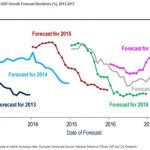The inherent fear of rising rates is something that income investors have dealt with through every major market cycle. Many have stubbornly adhered to the notion that the Fed’s monetary decisions and other fiscal shenanigans in the U.S. will ultimately cause a severe disruption in the bond market. Additionally, there has always been this chronic concern that inflationary pressures lurk just around the corner and will ultimately put pressure on bond prices.
The reality has been far tamer than many fear mongers or imaginative market technicians want you to believe. Interest rates have gone through a number of cyclical spikes over the last decade with fairly limited impact on diversified bond holders. The 2015 taper tantrum is one example, followed up by the more recent surge of Treasury Yields to what many are claiming as a counter-trend breakout.
Whatever view your take on the direction of interest rates, their overall trading patterns have been stable and orderly. The Treasury market is one of the most liquid and heavily traded in the world. As such, it has continued to plod a steady course that takes some of the fear out of the equation.

Examining a chart below of the iShares Core U.S. Aggregate Bond ETF (AGG) shows an inverse correlation with the direction of interest rates (as it should). Funny enough, the price action on the chart “looks” a lot worse than it really is. AGG has lost about -2.70% of its value since hitting a peak in September 2017. That’s about a fully years’ worth of dividends, but certainly not something to become overly fatalistic about.

One of the mistakes I often see bond holders make with their allocations is to try and apply too much technical and strategic logic to every little move in the market. Yes, AGG is below its long-term moving average. Yes, it is currently in a down-trend. However, the actual price decline is minimal and trying to trade every little 1% or 2% move in the bond market is like trying to catch a whiffle ball.














Leave A Comment